Pollution and exploitation of Marine ecosystem
VerifiedAdded on 2023/06/10
|9
|2359
|379
AI Summary
This article discusses the adverse effects of marine pollution and exploitation on the environment and biodiversity. It covers topics such as water contamination, plastic pollution, acid rain, and heavy metals. The article also explores the ethical issues surrounding marine pollution and the need for sustainable fishing practices.
Contribute Materials
Your contribution can guide someone’s learning journey. Share your
documents today.
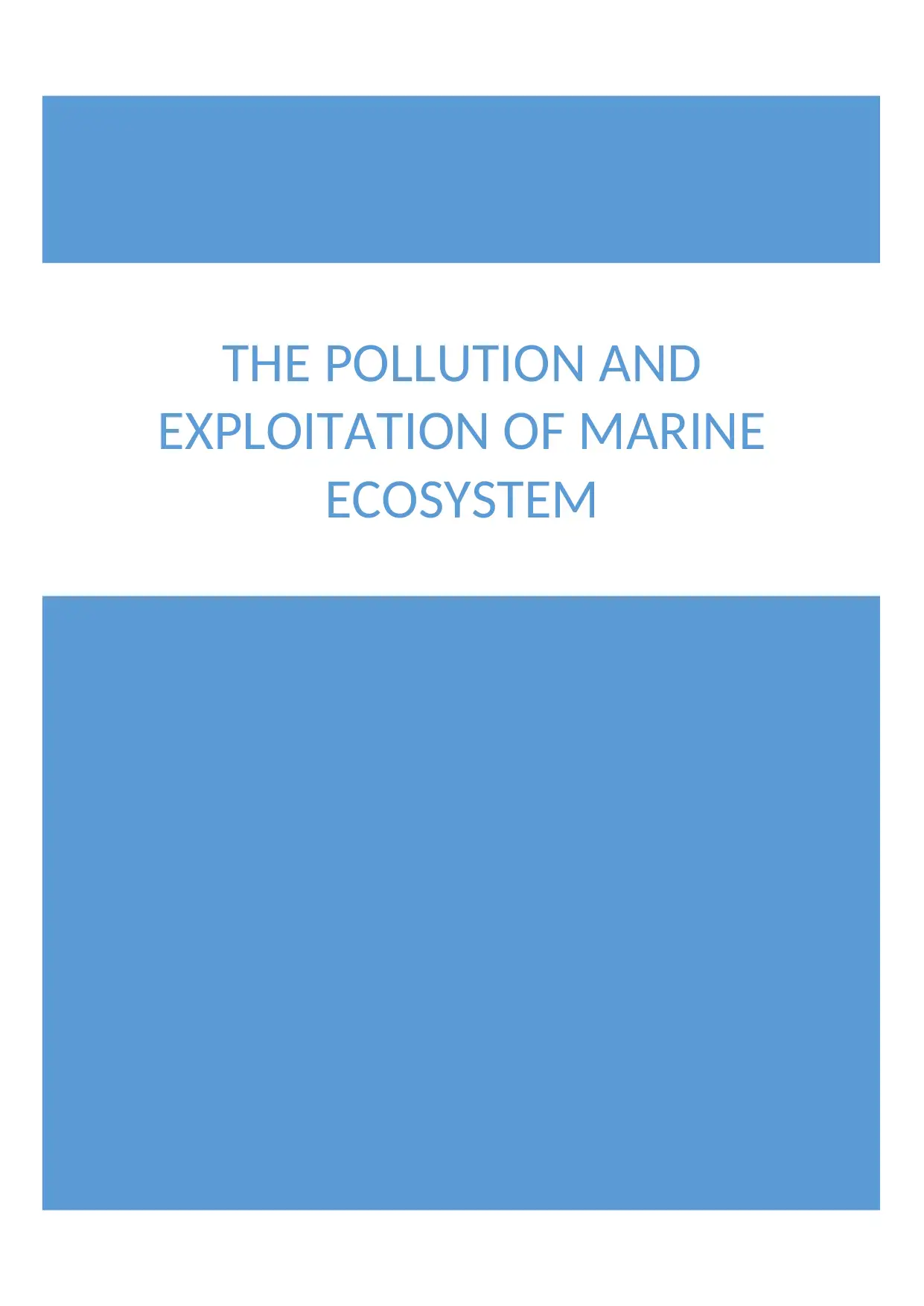
THE POLLUTION AND
EXPLOITATION OF MARINE
ECOSYSTEM
EXPLOITATION OF MARINE
ECOSYSTEM
Secure Best Marks with AI Grader
Need help grading? Try our AI Grader for instant feedback on your assignments.
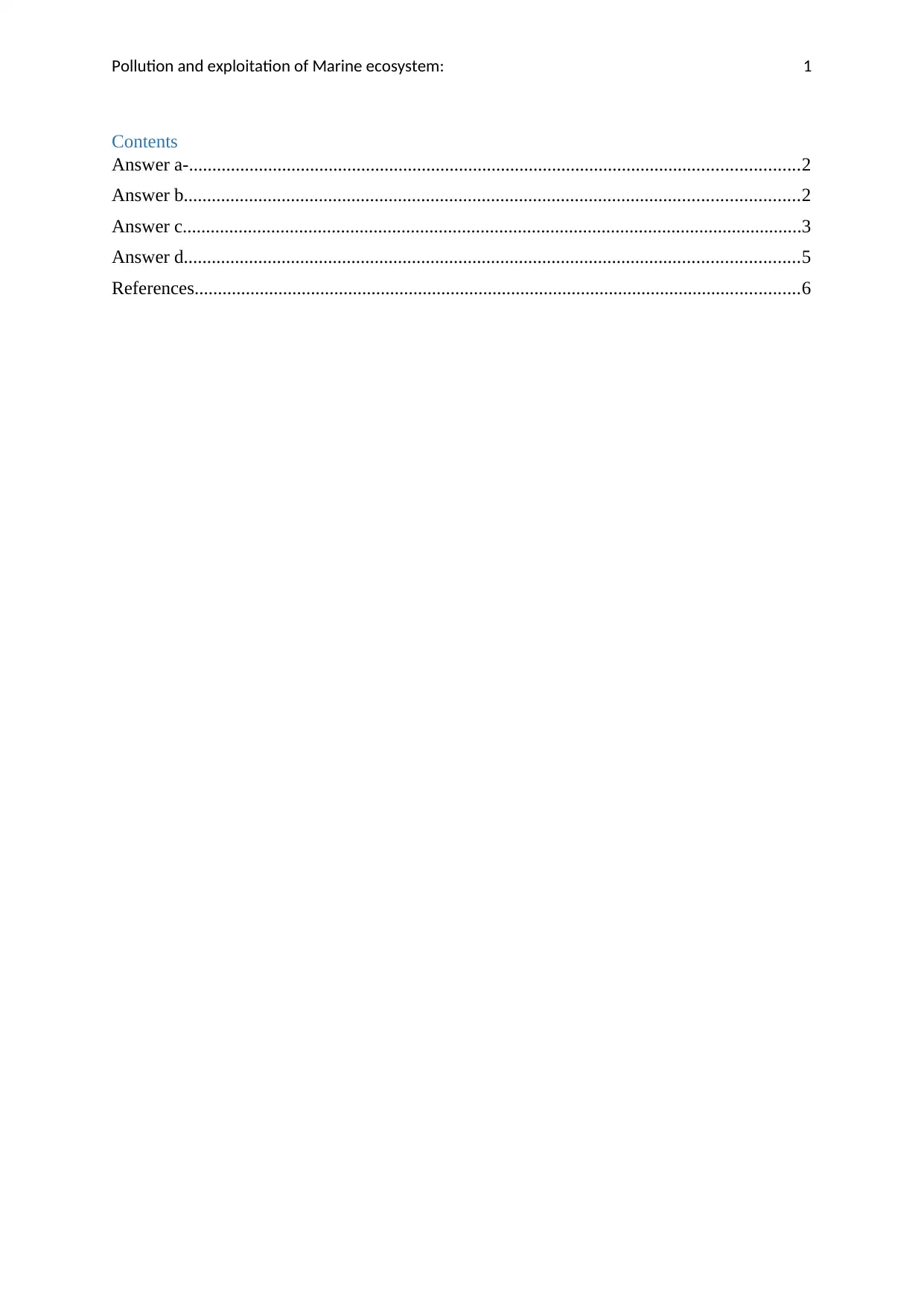
Pollution and exploitation of Marine ecosystem: 1
Contents
Answer a-...................................................................................................................................2
Answer b....................................................................................................................................2
Answer c.....................................................................................................................................3
Answer d....................................................................................................................................5
References..................................................................................................................................6
Contents
Answer a-...................................................................................................................................2
Answer b....................................................................................................................................2
Answer c.....................................................................................................................................3
Answer d....................................................................................................................................5
References..................................................................................................................................6
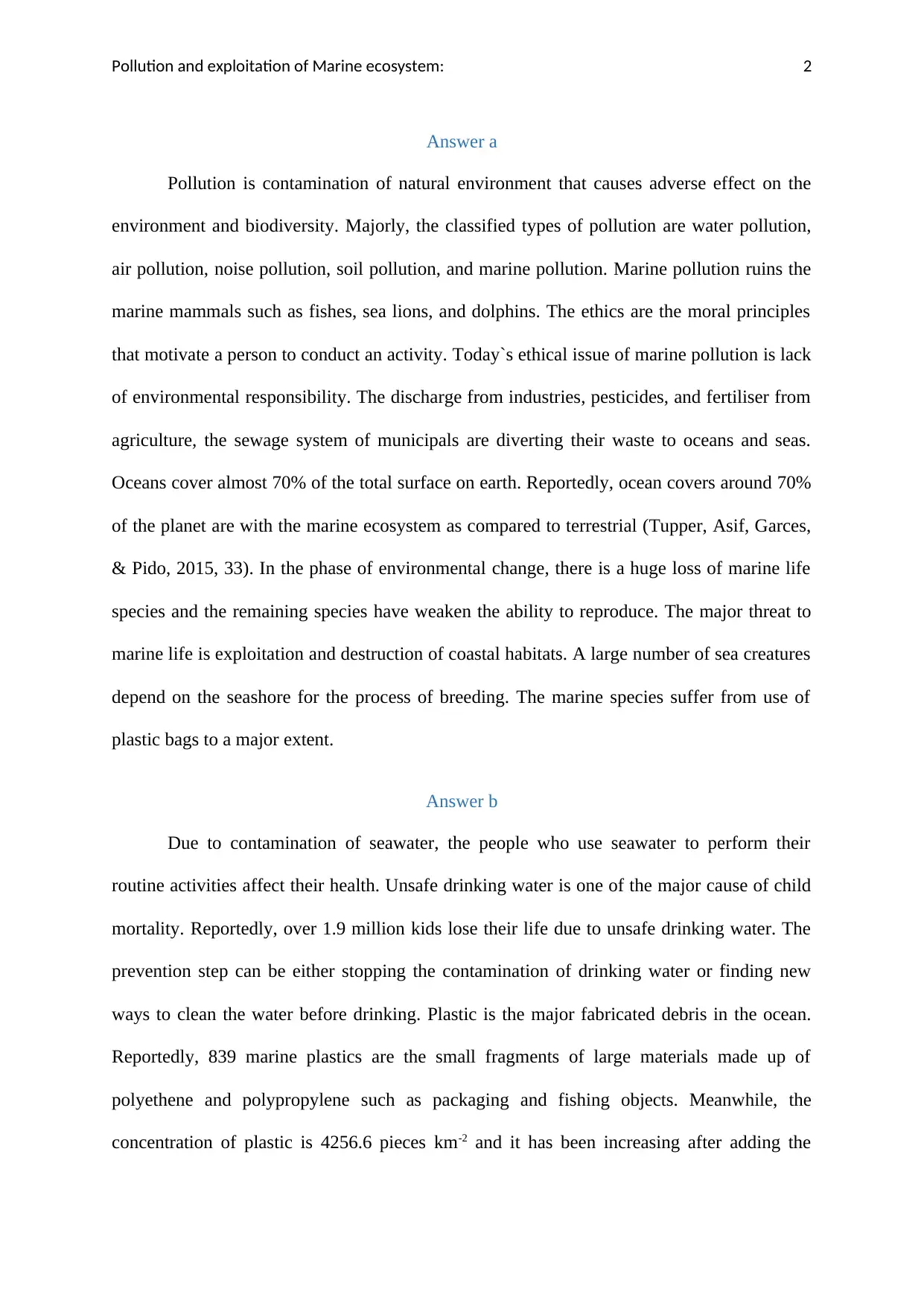
Pollution and exploitation of Marine ecosystem: 2
Answer a
Pollution is contamination of natural environment that causes adverse effect on the
environment and biodiversity. Majorly, the classified types of pollution are water pollution,
air pollution, noise pollution, soil pollution, and marine pollution. Marine pollution ruins the
marine mammals such as fishes, sea lions, and dolphins. The ethics are the moral principles
that motivate a person to conduct an activity. Today`s ethical issue of marine pollution is lack
of environmental responsibility. The discharge from industries, pesticides, and fertiliser from
agriculture, the sewage system of municipals are diverting their waste to oceans and seas.
Oceans cover almost 70% of the total surface on earth. Reportedly, ocean covers around 70%
of the planet are with the marine ecosystem as compared to terrestrial (Tupper, Asif, Garces,
& Pido, 2015, 33). In the phase of environmental change, there is a huge loss of marine life
species and the remaining species have weaken the ability to reproduce. The major threat to
marine life is exploitation and destruction of coastal habitats. A large number of sea creatures
depend on the seashore for the process of breeding. The marine species suffer from use of
plastic bags to a major extent.
Answer b
Due to contamination of seawater, the people who use seawater to perform their
routine activities affect their health. Unsafe drinking water is one of the major cause of child
mortality. Reportedly, over 1.9 million kids lose their life due to unsafe drinking water. The
prevention step can be either stopping the contamination of drinking water or finding new
ways to clean the water before drinking. Plastic is the major fabricated debris in the ocean.
Reportedly, 839 marine plastics are the small fragments of large materials made up of
polyethene and polypropylene such as packaging and fishing objects. Meanwhile, the
concentration of plastic is 4256.6 pieces km-2 and it has been increasing after adding the
Answer a
Pollution is contamination of natural environment that causes adverse effect on the
environment and biodiversity. Majorly, the classified types of pollution are water pollution,
air pollution, noise pollution, soil pollution, and marine pollution. Marine pollution ruins the
marine mammals such as fishes, sea lions, and dolphins. The ethics are the moral principles
that motivate a person to conduct an activity. Today`s ethical issue of marine pollution is lack
of environmental responsibility. The discharge from industries, pesticides, and fertiliser from
agriculture, the sewage system of municipals are diverting their waste to oceans and seas.
Oceans cover almost 70% of the total surface on earth. Reportedly, ocean covers around 70%
of the planet are with the marine ecosystem as compared to terrestrial (Tupper, Asif, Garces,
& Pido, 2015, 33). In the phase of environmental change, there is a huge loss of marine life
species and the remaining species have weaken the ability to reproduce. The major threat to
marine life is exploitation and destruction of coastal habitats. A large number of sea creatures
depend on the seashore for the process of breeding. The marine species suffer from use of
plastic bags to a major extent.
Answer b
Due to contamination of seawater, the people who use seawater to perform their
routine activities affect their health. Unsafe drinking water is one of the major cause of child
mortality. Reportedly, over 1.9 million kids lose their life due to unsafe drinking water. The
prevention step can be either stopping the contamination of drinking water or finding new
ways to clean the water before drinking. Plastic is the major fabricated debris in the ocean.
Reportedly, 839 marine plastics are the small fragments of large materials made up of
polyethene and polypropylene such as packaging and fishing objects. Meanwhile, the
concentration of plastic is 4256.6 pieces km-2 and it has been increasing after adding the
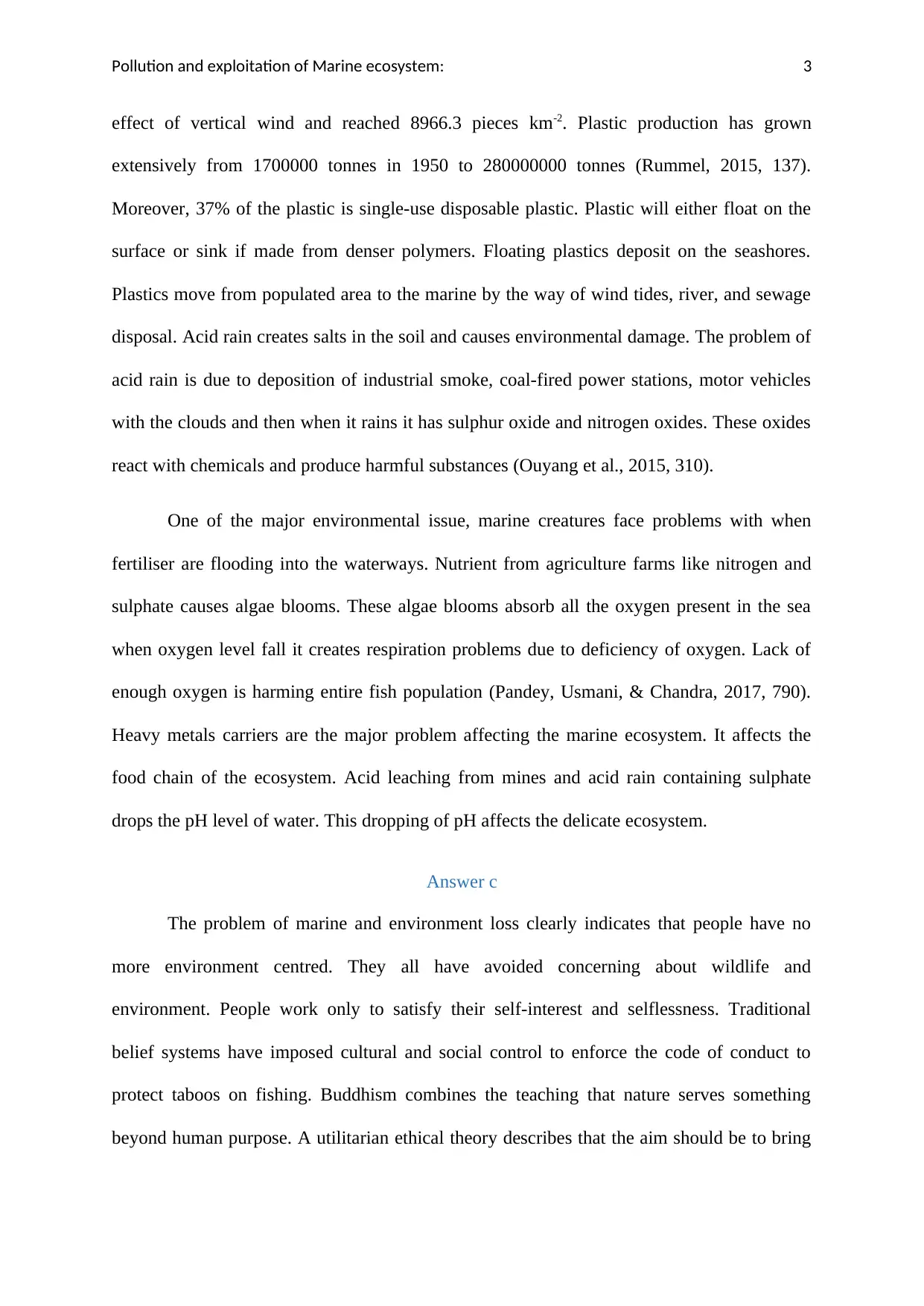
Pollution and exploitation of Marine ecosystem: 3
effect of vertical wind and reached 8966.3 pieces km-2. Plastic production has grown
extensively from 1700000 tonnes in 1950 to 280000000 tonnes (Rummel, 2015, 137).
Moreover, 37% of the plastic is single-use disposable plastic. Plastic will either float on the
surface or sink if made from denser polymers. Floating plastics deposit on the seashores.
Plastics move from populated area to the marine by the way of wind tides, river, and sewage
disposal. Acid rain creates salts in the soil and causes environmental damage. The problem of
acid rain is due to deposition of industrial smoke, coal-fired power stations, motor vehicles
with the clouds and then when it rains it has sulphur oxide and nitrogen oxides. These oxides
react with chemicals and produce harmful substances (Ouyang et al., 2015, 310).
One of the major environmental issue, marine creatures face problems with when
fertiliser are flooding into the waterways. Nutrient from agriculture farms like nitrogen and
sulphate causes algae blooms. These algae blooms absorb all the oxygen present in the sea
when oxygen level fall it creates respiration problems due to deficiency of oxygen. Lack of
enough oxygen is harming entire fish population (Pandey, Usmani, & Chandra, 2017, 790).
Heavy metals carriers are the major problem affecting the marine ecosystem. It affects the
food chain of the ecosystem. Acid leaching from mines and acid rain containing sulphate
drops the pH level of water. This dropping of pH affects the delicate ecosystem.
Answer c
The problem of marine and environment loss clearly indicates that people have no
more environment centred. They all have avoided concerning about wildlife and
environment. People work only to satisfy their self-interest and selflessness. Traditional
belief systems have imposed cultural and social control to enforce the code of conduct to
protect taboos on fishing. Buddhism combines the teaching that nature serves something
beyond human purpose. A utilitarian ethical theory describes that the aim should be to bring
effect of vertical wind and reached 8966.3 pieces km-2. Plastic production has grown
extensively from 1700000 tonnes in 1950 to 280000000 tonnes (Rummel, 2015, 137).
Moreover, 37% of the plastic is single-use disposable plastic. Plastic will either float on the
surface or sink if made from denser polymers. Floating plastics deposit on the seashores.
Plastics move from populated area to the marine by the way of wind tides, river, and sewage
disposal. Acid rain creates salts in the soil and causes environmental damage. The problem of
acid rain is due to deposition of industrial smoke, coal-fired power stations, motor vehicles
with the clouds and then when it rains it has sulphur oxide and nitrogen oxides. These oxides
react with chemicals and produce harmful substances (Ouyang et al., 2015, 310).
One of the major environmental issue, marine creatures face problems with when
fertiliser are flooding into the waterways. Nutrient from agriculture farms like nitrogen and
sulphate causes algae blooms. These algae blooms absorb all the oxygen present in the sea
when oxygen level fall it creates respiration problems due to deficiency of oxygen. Lack of
enough oxygen is harming entire fish population (Pandey, Usmani, & Chandra, 2017, 790).
Heavy metals carriers are the major problem affecting the marine ecosystem. It affects the
food chain of the ecosystem. Acid leaching from mines and acid rain containing sulphate
drops the pH level of water. This dropping of pH affects the delicate ecosystem.
Answer c
The problem of marine and environment loss clearly indicates that people have no
more environment centred. They all have avoided concerning about wildlife and
environment. People work only to satisfy their self-interest and selflessness. Traditional
belief systems have imposed cultural and social control to enforce the code of conduct to
protect taboos on fishing. Buddhism combines the teaching that nature serves something
beyond human purpose. A utilitarian ethical theory describes that the aim should be to bring
Secure Best Marks with AI Grader
Need help grading? Try our AI Grader for instant feedback on your assignments.
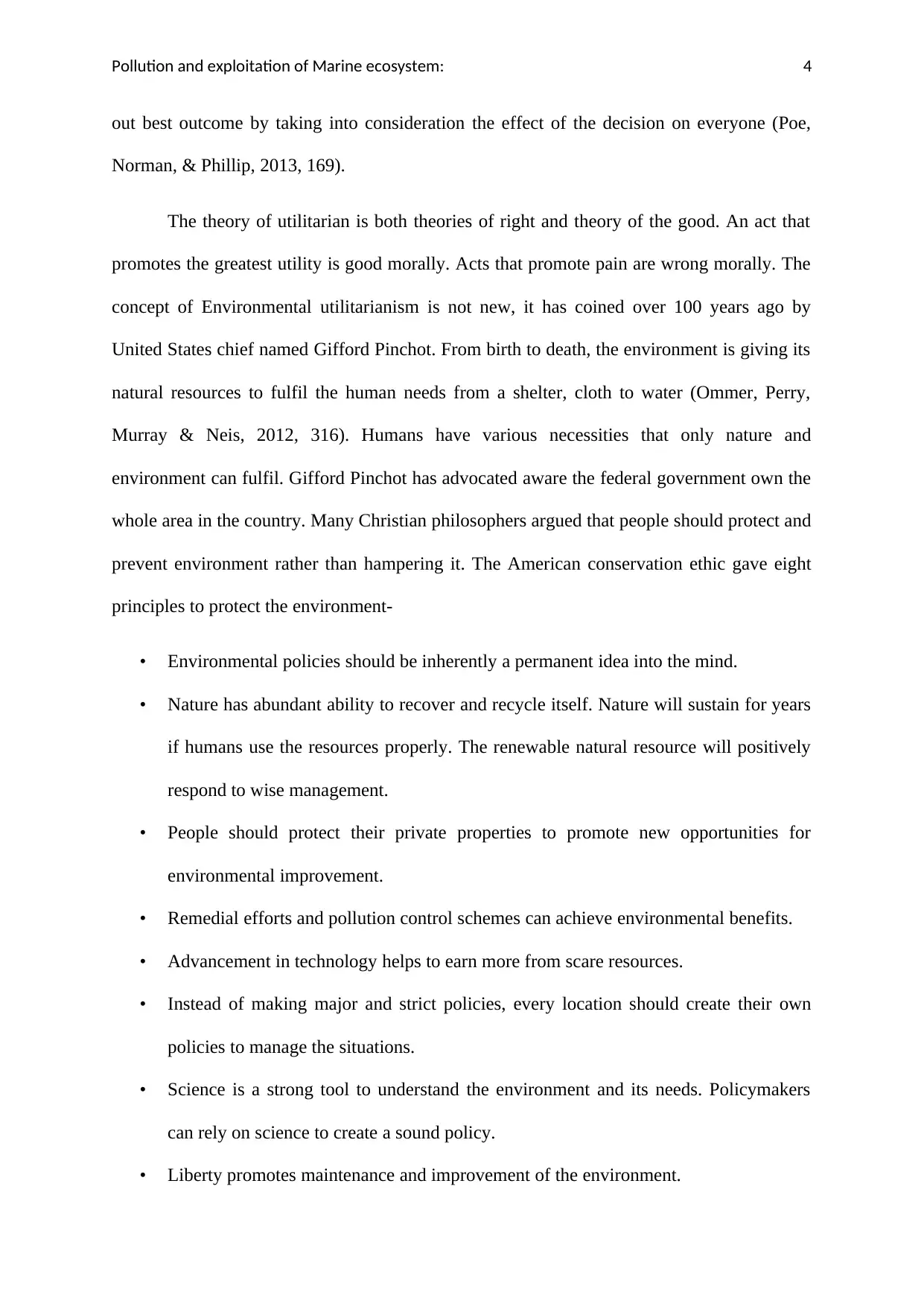
Pollution and exploitation of Marine ecosystem: 4
out best outcome by taking into consideration the effect of the decision on everyone (Poe,
Norman, & Phillip, 2013, 169).
The theory of utilitarian is both theories of right and theory of the good. An act that
promotes the greatest utility is good morally. Acts that promote pain are wrong morally. The
concept of Environmental utilitarianism is not new, it has coined over 100 years ago by
United States chief named Gifford Pinchot. From birth to death, the environment is giving its
natural resources to fulfil the human needs from a shelter, cloth to water (Ommer, Perry,
Murray & Neis, 2012, 316). Humans have various necessities that only nature and
environment can fulfil. Gifford Pinchot has advocated aware the federal government own the
whole area in the country. Many Christian philosophers argued that people should protect and
prevent environment rather than hampering it. The American conservation ethic gave eight
principles to protect the environment-
• Environmental policies should be inherently a permanent idea into the mind.
• Nature has abundant ability to recover and recycle itself. Nature will sustain for years
if humans use the resources properly. The renewable natural resource will positively
respond to wise management.
• People should protect their private properties to promote new opportunities for
environmental improvement.
• Remedial efforts and pollution control schemes can achieve environmental benefits.
• Advancement in technology helps to earn more from scare resources.
• Instead of making major and strict policies, every location should create their own
policies to manage the situations.
• Science is a strong tool to understand the environment and its needs. Policymakers
can rely on science to create a sound policy.
• Liberty promotes maintenance and improvement of the environment.
out best outcome by taking into consideration the effect of the decision on everyone (Poe,
Norman, & Phillip, 2013, 169).
The theory of utilitarian is both theories of right and theory of the good. An act that
promotes the greatest utility is good morally. Acts that promote pain are wrong morally. The
concept of Environmental utilitarianism is not new, it has coined over 100 years ago by
United States chief named Gifford Pinchot. From birth to death, the environment is giving its
natural resources to fulfil the human needs from a shelter, cloth to water (Ommer, Perry,
Murray & Neis, 2012, 316). Humans have various necessities that only nature and
environment can fulfil. Gifford Pinchot has advocated aware the federal government own the
whole area in the country. Many Christian philosophers argued that people should protect and
prevent environment rather than hampering it. The American conservation ethic gave eight
principles to protect the environment-
• Environmental policies should be inherently a permanent idea into the mind.
• Nature has abundant ability to recover and recycle itself. Nature will sustain for years
if humans use the resources properly. The renewable natural resource will positively
respond to wise management.
• People should protect their private properties to promote new opportunities for
environmental improvement.
• Remedial efforts and pollution control schemes can achieve environmental benefits.
• Advancement in technology helps to earn more from scare resources.
• Instead of making major and strict policies, every location should create their own
policies to manage the situations.
• Science is a strong tool to understand the environment and its needs. Policymakers
can rely on science to create a sound policy.
• Liberty promotes maintenance and improvement of the environment.
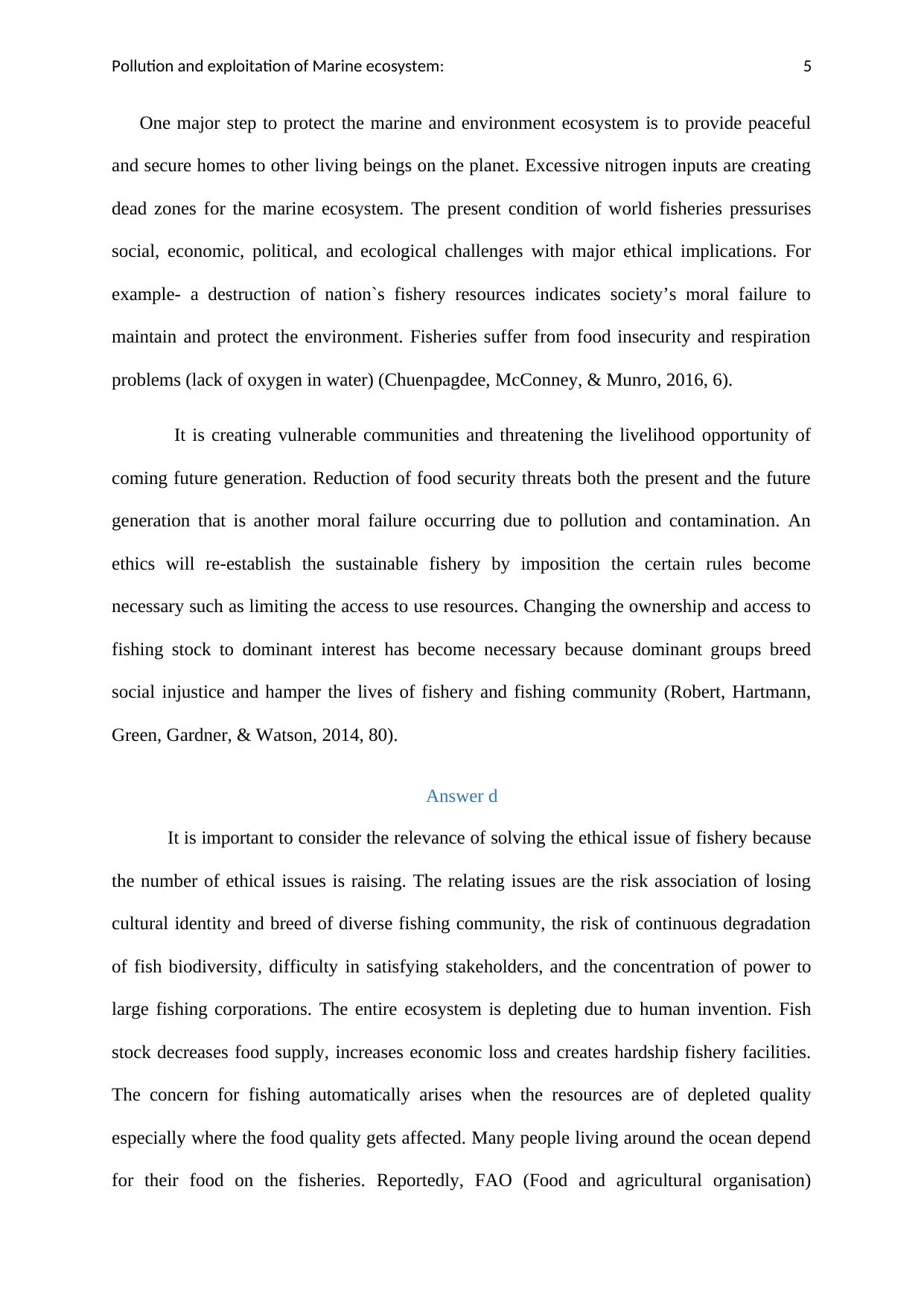
Pollution and exploitation of Marine ecosystem: 5
One major step to protect the marine and environment ecosystem is to provide peaceful
and secure homes to other living beings on the planet. Excessive nitrogen inputs are creating
dead zones for the marine ecosystem. The present condition of world fisheries pressurises
social, economic, political, and ecological challenges with major ethical implications. For
example- a destruction of nation`s fishery resources indicates society’s moral failure to
maintain and protect the environment. Fisheries suffer from food insecurity and respiration
problems (lack of oxygen in water) (Chuenpagdee, McConney, & Munro, 2016, 6).
It is creating vulnerable communities and threatening the livelihood opportunity of
coming future generation. Reduction of food security threats both the present and the future
generation that is another moral failure occurring due to pollution and contamination. An
ethics will re-establish the sustainable fishery by imposition the certain rules become
necessary such as limiting the access to use resources. Changing the ownership and access to
fishing stock to dominant interest has become necessary because dominant groups breed
social injustice and hamper the lives of fishery and fishing community (Robert, Hartmann,
Green, Gardner, & Watson, 2014, 80).
Answer d
It is important to consider the relevance of solving the ethical issue of fishery because
the number of ethical issues is raising. The relating issues are the risk association of losing
cultural identity and breed of diverse fishing community, the risk of continuous degradation
of fish biodiversity, difficulty in satisfying stakeholders, and the concentration of power to
large fishing corporations. The entire ecosystem is depleting due to human invention. Fish
stock decreases food supply, increases economic loss and creates hardship fishery facilities.
The concern for fishing automatically arises when the resources are of depleted quality
especially where the food quality gets affected. Many people living around the ocean depend
for their food on the fisheries. Reportedly, FAO (Food and agricultural organisation)
One major step to protect the marine and environment ecosystem is to provide peaceful
and secure homes to other living beings on the planet. Excessive nitrogen inputs are creating
dead zones for the marine ecosystem. The present condition of world fisheries pressurises
social, economic, political, and ecological challenges with major ethical implications. For
example- a destruction of nation`s fishery resources indicates society’s moral failure to
maintain and protect the environment. Fisheries suffer from food insecurity and respiration
problems (lack of oxygen in water) (Chuenpagdee, McConney, & Munro, 2016, 6).
It is creating vulnerable communities and threatening the livelihood opportunity of
coming future generation. Reduction of food security threats both the present and the future
generation that is another moral failure occurring due to pollution and contamination. An
ethics will re-establish the sustainable fishery by imposition the certain rules become
necessary such as limiting the access to use resources. Changing the ownership and access to
fishing stock to dominant interest has become necessary because dominant groups breed
social injustice and hamper the lives of fishery and fishing community (Robert, Hartmann,
Green, Gardner, & Watson, 2014, 80).
Answer d
It is important to consider the relevance of solving the ethical issue of fishery because
the number of ethical issues is raising. The relating issues are the risk association of losing
cultural identity and breed of diverse fishing community, the risk of continuous degradation
of fish biodiversity, difficulty in satisfying stakeholders, and the concentration of power to
large fishing corporations. The entire ecosystem is depleting due to human invention. Fish
stock decreases food supply, increases economic loss and creates hardship fishery facilities.
The concern for fishing automatically arises when the resources are of depleted quality
especially where the food quality gets affected. Many people living around the ocean depend
for their food on the fisheries. Reportedly, FAO (Food and agricultural organisation)
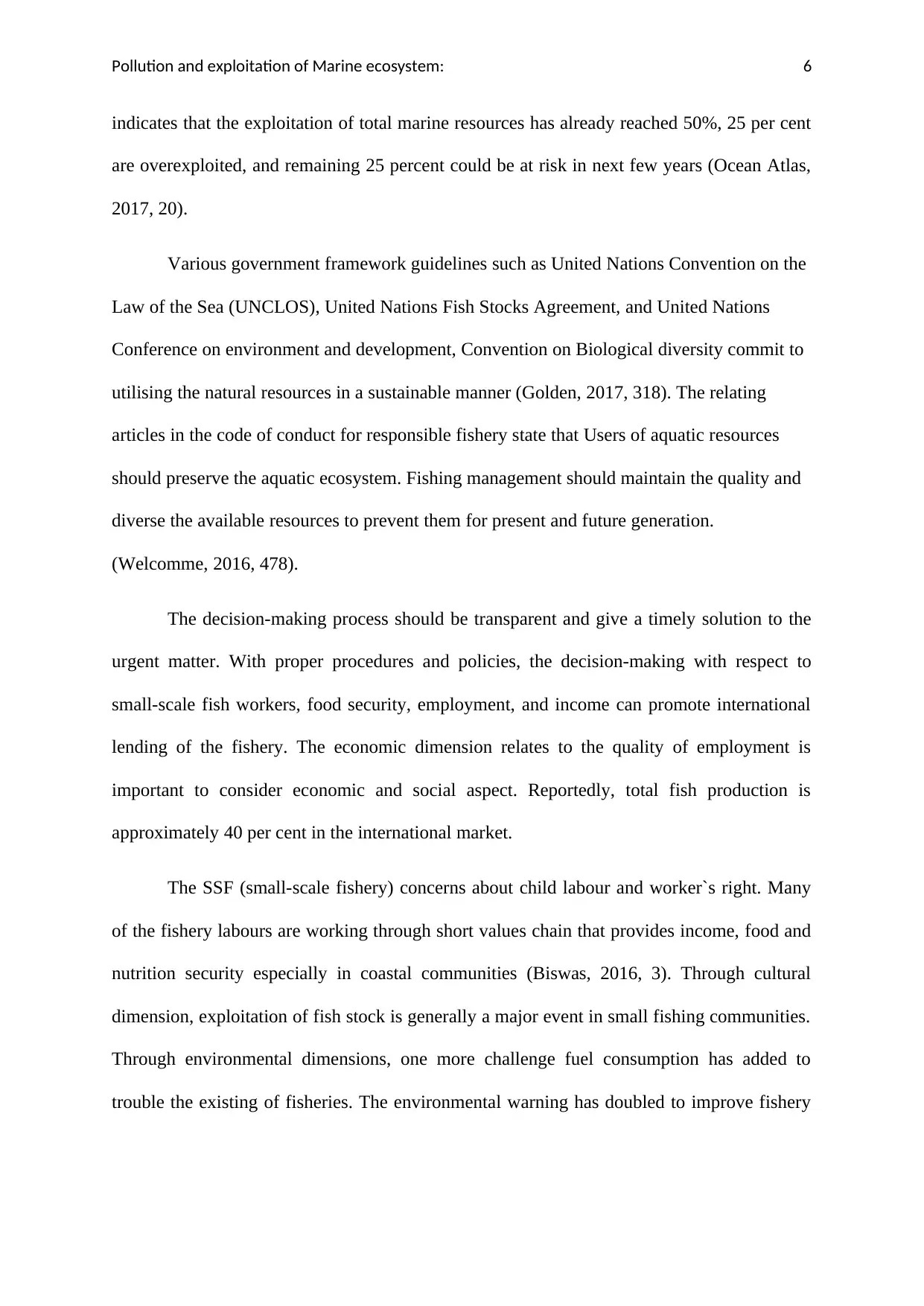
Pollution and exploitation of Marine ecosystem: 6
indicates that the exploitation of total marine resources has already reached 50%, 25 per cent
are overexploited, and remaining 25 percent could be at risk in next few years (Ocean Atlas,
2017, 20).
Various government framework guidelines such as United Nations Convention on the
Law of the Sea (UNCLOS), United Nations Fish Stocks Agreement, and United Nations
Conference on environment and development, Convention on Biological diversity commit to
utilising the natural resources in a sustainable manner (Golden, 2017, 318). The relating
articles in the code of conduct for responsible fishery state that Users of aquatic resources
should preserve the aquatic ecosystem. Fishing management should maintain the quality and
diverse the available resources to prevent them for present and future generation.
(Welcomme, 2016, 478).
The decision-making process should be transparent and give a timely solution to the
urgent matter. With proper procedures and policies, the decision-making with respect to
small-scale fish workers, food security, employment, and income can promote international
lending of the fishery. The economic dimension relates to the quality of employment is
important to consider economic and social aspect. Reportedly, total fish production is
approximately 40 per cent in the international market.
The SSF (small-scale fishery) concerns about child labour and worker`s right. Many
of the fishery labours are working through short values chain that provides income, food and
nutrition security especially in coastal communities (Biswas, 2016, 3). Through cultural
dimension, exploitation of fish stock is generally a major event in small fishing communities.
Through environmental dimensions, one more challenge fuel consumption has added to
trouble the existing of fisheries. The environmental warning has doubled to improve fishery
indicates that the exploitation of total marine resources has already reached 50%, 25 per cent
are overexploited, and remaining 25 percent could be at risk in next few years (Ocean Atlas,
2017, 20).
Various government framework guidelines such as United Nations Convention on the
Law of the Sea (UNCLOS), United Nations Fish Stocks Agreement, and United Nations
Conference on environment and development, Convention on Biological diversity commit to
utilising the natural resources in a sustainable manner (Golden, 2017, 318). The relating
articles in the code of conduct for responsible fishery state that Users of aquatic resources
should preserve the aquatic ecosystem. Fishing management should maintain the quality and
diverse the available resources to prevent them for present and future generation.
(Welcomme, 2016, 478).
The decision-making process should be transparent and give a timely solution to the
urgent matter. With proper procedures and policies, the decision-making with respect to
small-scale fish workers, food security, employment, and income can promote international
lending of the fishery. The economic dimension relates to the quality of employment is
important to consider economic and social aspect. Reportedly, total fish production is
approximately 40 per cent in the international market.
The SSF (small-scale fishery) concerns about child labour and worker`s right. Many
of the fishery labours are working through short values chain that provides income, food and
nutrition security especially in coastal communities (Biswas, 2016, 3). Through cultural
dimension, exploitation of fish stock is generally a major event in small fishing communities.
Through environmental dimensions, one more challenge fuel consumption has added to
trouble the existing of fisheries. The environmental warning has doubled to improve fishery
Paraphrase This Document
Need a fresh take? Get an instant paraphrase of this document with our AI Paraphraser
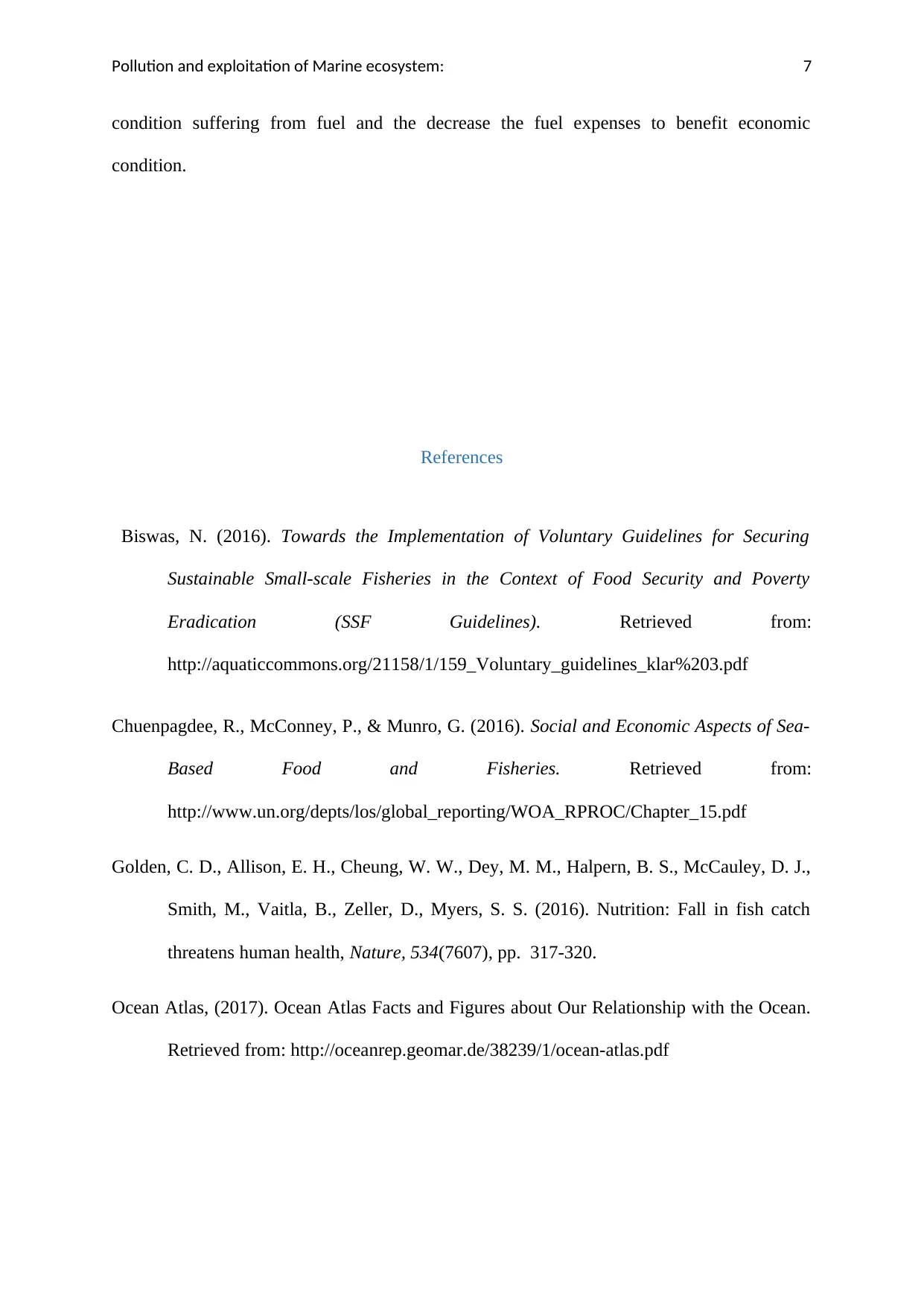
Pollution and exploitation of Marine ecosystem: 7
condition suffering from fuel and the decrease the fuel expenses to benefit economic
condition.
References
Biswas, N. (2016). Towards the Implementation of Voluntary Guidelines for Securing
Sustainable Small-scale Fisheries in the Context of Food Security and Poverty
Eradication (SSF Guidelines). Retrieved from:
http://aquaticcommons.org/21158/1/159_Voluntary_guidelines_klar%203.pdf
Chuenpagdee, R., McConney, P., & Munro, G. (2016). Social and Economic Aspects of Sea-
Based Food and Fisheries. Retrieved from:
http://www.un.org/depts/los/global_reporting/WOA_RPROC/Chapter_15.pdf
Golden, C. D., Allison, E. H., Cheung, W. W., Dey, M. M., Halpern, B. S., McCauley, D. J.,
Smith, M., Vaitla, B., Zeller, D., Myers, S. S. (2016). Nutrition: Fall in fish catch
threatens human health, Nature, 534(7607), pp. 317-320.
Ocean Atlas, (2017). Ocean Atlas Facts and Figures about Our Relationship with the Ocean.
Retrieved from: http://oceanrep.geomar.de/38239/1/ocean-atlas.pdf
condition suffering from fuel and the decrease the fuel expenses to benefit economic
condition.
References
Biswas, N. (2016). Towards the Implementation of Voluntary Guidelines for Securing
Sustainable Small-scale Fisheries in the Context of Food Security and Poverty
Eradication (SSF Guidelines). Retrieved from:
http://aquaticcommons.org/21158/1/159_Voluntary_guidelines_klar%203.pdf
Chuenpagdee, R., McConney, P., & Munro, G. (2016). Social and Economic Aspects of Sea-
Based Food and Fisheries. Retrieved from:
http://www.un.org/depts/los/global_reporting/WOA_RPROC/Chapter_15.pdf
Golden, C. D., Allison, E. H., Cheung, W. W., Dey, M. M., Halpern, B. S., McCauley, D. J.,
Smith, M., Vaitla, B., Zeller, D., Myers, S. S. (2016). Nutrition: Fall in fish catch
threatens human health, Nature, 534(7607), pp. 317-320.
Ocean Atlas, (2017). Ocean Atlas Facts and Figures about Our Relationship with the Ocean.
Retrieved from: http://oceanrep.geomar.de/38239/1/ocean-atlas.pdf
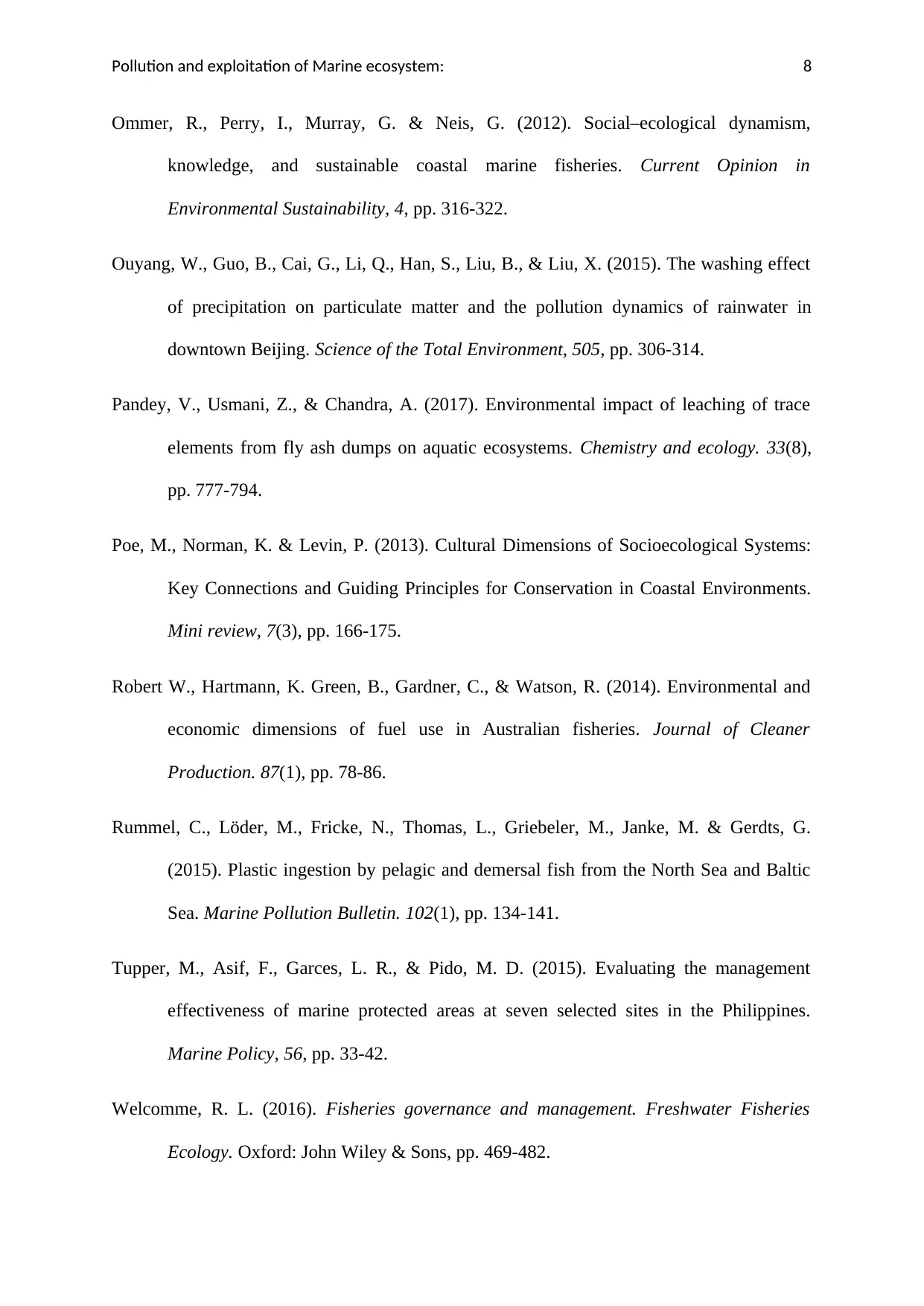
Pollution and exploitation of Marine ecosystem: 8
Ommer, R., Perry, I., Murray, G. & Neis, G. (2012). Social–ecological dynamism,
knowledge, and sustainable coastal marine fisheries. Current Opinion in
Environmental Sustainability, 4, pp. 316-322.
Ouyang, W., Guo, B., Cai, G., Li, Q., Han, S., Liu, B., & Liu, X. (2015). The washing effect
of precipitation on particulate matter and the pollution dynamics of rainwater in
downtown Beijing. Science of the Total Environment, 505, pp. 306-314.
Pandey, V., Usmani, Z., & Chandra, A. (2017). Environmental impact of leaching of trace
elements from fly ash dumps on aquatic ecosystems. Chemistry and ecology. 33(8),
pp. 777-794.
Poe, M., Norman, K. & Levin, P. (2013). Cultural Dimensions of Socioecological Systems:
Key Connections and Guiding Principles for Conservation in Coastal Environments.
Mini review, 7(3), pp. 166-175.
Robert W., Hartmann, K. Green, B., Gardner, C., & Watson, R. (2014). Environmental and
economic dimensions of fuel use in Australian fisheries. Journal of Cleaner
Production. 87(1), pp. 78-86.
Rummel, C., Löder, M., Fricke, N., Thomas, L., Griebeler, M., Janke, M. & Gerdts, G.
(2015). Plastic ingestion by pelagic and demersal fish from the North Sea and Baltic
Sea. Marine Pollution Bulletin. 102(1), pp. 134-141.
Tupper, M., Asif, F., Garces, L. R., & Pido, M. D. (2015). Evaluating the management
effectiveness of marine protected areas at seven selected sites in the Philippines.
Marine Policy, 56, pp. 33-42.
Welcomme, R. L. (2016). Fisheries governance and management. Freshwater Fisheries
Ecology. Oxford: John Wiley & Sons, pp. 469-482.
Ommer, R., Perry, I., Murray, G. & Neis, G. (2012). Social–ecological dynamism,
knowledge, and sustainable coastal marine fisheries. Current Opinion in
Environmental Sustainability, 4, pp. 316-322.
Ouyang, W., Guo, B., Cai, G., Li, Q., Han, S., Liu, B., & Liu, X. (2015). The washing effect
of precipitation on particulate matter and the pollution dynamics of rainwater in
downtown Beijing. Science of the Total Environment, 505, pp. 306-314.
Pandey, V., Usmani, Z., & Chandra, A. (2017). Environmental impact of leaching of trace
elements from fly ash dumps on aquatic ecosystems. Chemistry and ecology. 33(8),
pp. 777-794.
Poe, M., Norman, K. & Levin, P. (2013). Cultural Dimensions of Socioecological Systems:
Key Connections and Guiding Principles for Conservation in Coastal Environments.
Mini review, 7(3), pp. 166-175.
Robert W., Hartmann, K. Green, B., Gardner, C., & Watson, R. (2014). Environmental and
economic dimensions of fuel use in Australian fisheries. Journal of Cleaner
Production. 87(1), pp. 78-86.
Rummel, C., Löder, M., Fricke, N., Thomas, L., Griebeler, M., Janke, M. & Gerdts, G.
(2015). Plastic ingestion by pelagic and demersal fish from the North Sea and Baltic
Sea. Marine Pollution Bulletin. 102(1), pp. 134-141.
Tupper, M., Asif, F., Garces, L. R., & Pido, M. D. (2015). Evaluating the management
effectiveness of marine protected areas at seven selected sites in the Philippines.
Marine Policy, 56, pp. 33-42.
Welcomme, R. L. (2016). Fisheries governance and management. Freshwater Fisheries
Ecology. Oxford: John Wiley & Sons, pp. 469-482.
1 out of 9
Related Documents
Your All-in-One AI-Powered Toolkit for Academic Success.
+13062052269
info@desklib.com
Available 24*7 on WhatsApp / Email
![[object Object]](/_next/static/media/star-bottom.7253800d.svg)
Unlock your academic potential
© 2024 | Zucol Services PVT LTD | All rights reserved.




